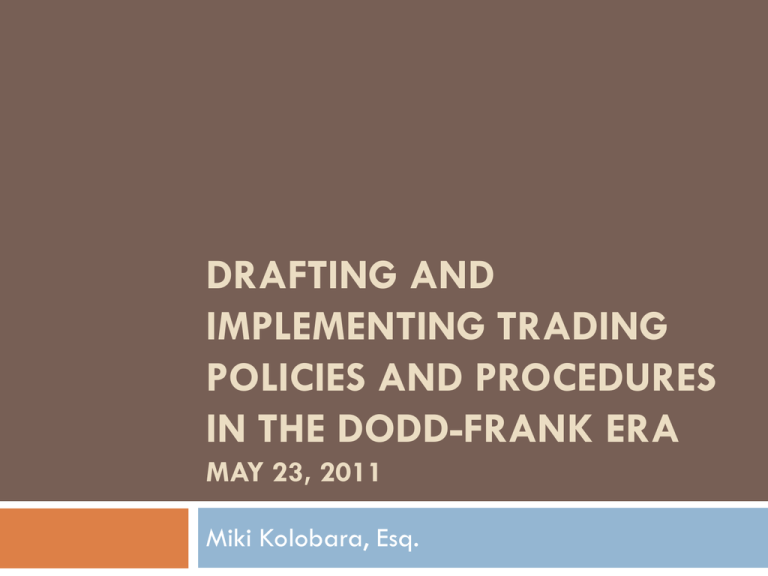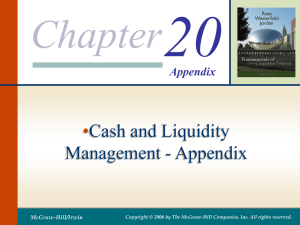May 23 – Slides - Energy Trading Compliance Blog
advertisement

DRAFTING AND IMPLEMENTING TRADING POLICIES AND PROCEDURES IN THE DODD-FRANK ERA MAY 23, 2011 Miki Kolobara, Esq. The Dodd-Frank Act 2 The Dodd-Frank Act injects an unprecedented amount of uncertainty into the energy trading arena due to: The misunderstood role of derivatives in the 2008 financial meltdown; The overambitious scope of the statute; The lack of detailed guidance; and The inconsistency between the substance of the statute and the stated intent. 2011 © Miki Kolobara, Esq. The Dodd-Frank Act 3 The Dodd-Frank Act is the first federal statute that requires market participants to have a derivatives risk management program. It will create an unreasonable financial and operational burden for companies that had nothing to do with the 2008 financial crisis. 2011 © Miki Kolobara, Esq. Trading Policies and Procedures 4 Trading/risk management policies and procedures are generally established to govern the scope of commodity trading and risk management activities for energy market participants. 2011 © Miki Kolobara, Esq. Trading Policies and Procedures 5 Trading policies and procedures should define and specify the controls and management responsibility associated with trading and risk management, and provide a framework in which management can maintain a portfolio of transactions within predefined risk parameters. 2011 © Miki Kolobara, Esq. Trading Policies and Procedures 6 In order to adequately identify, quantify and manage the relevant Dodd-Frank Act risks, energy market participants will have review and evaluate the trading and/or risk management policies and procedures. 2011 © Miki Kolobara, Esq. Key Elements to Include in Trading Policies and Procedures 7 A clear directive from the governing body (Board/Audit Committee/Risk Oversight Committee) approving the trading and exposure management activities, as well as the establishment of management’s accountability with respect to the compliance of trading and risk management activities. 2011 © Miki Kolobara, Esq. Key Elements to Include in Trading Policies and Procedures 8 Clear segregation of duties on the trade floor including up-front deal flow analysis, independent monitoring (including independent valuations, price curves, models, and stress testing), and effective reporting. 2011 © Miki Kolobara, Esq. Key Elements to Include in Trading Policies and Procedures 9 A clearly defined appetite for risk, from a corporate viewpoint, including the exposure and position limits, stop loss limits, approved trading strategies and products, as well as approved markets (“trading around assets” is not a recognized trading strategy for the purpose of risk management or compliance). 2011 © Miki Kolobara, Esq. Key Elements to Include in Trading Policies and Procedures 10 A clearly outlined sequence of events for entering into trades (including any prior review and approval by various groups – credit, risk, tax, legal), verifying and confirming the trades, and following up with any further steps (such as option exercise notifications, and calculation period resets for rate swaps). 2011 © Miki Kolobara, Esq. Key Elements to Include in Trading Policies and Procedures 11 Sufficient documentation should be maintained for every swap to ensure consistent and adequate legal and contractual protections across portfolio(s), including the pre-execution and post-execution phase. 2011 © Miki Kolobara, Esq. Key Elements to Include in Trading Policies and Procedures 12 Mandatory training requirements for all trading personnel to ensure that the most current and appropriate regulatory requirements are timely communicated to everyone involved in the trading/risk management activities. 2011 © Miki Kolobara, Esq. Key Elements to Include in Trading Policies and Procedures 13 Strong emphasis on creating and maintaining a culture of compliance, both internally and externally, including, but not limited to: anti-manipulation rules and prohibited trading strategies, price reporting rules, exchange position limit rules, large trader reporting requirements, and the bona fide hedge definition. 2011 © Miki Kolobara, Esq. Key Elements to Include in Trading Policies and Procedures 14 Continuous and consistent enforcement, including appropriate sanctions for violating policies and procedures. 2011 © Miki Kolobara, Esq. Authorized Trading Practices 15 A policy should list all authorized trading practices and a brief explanation of every such authorized practice. Clarity required to define hedging. 2011 © Miki Kolobara, Esq. Risk Management 16 A policy should have a clear statement that management and employees involved in trading or risk management activities at all levels of the company have a responsibility to understand the objectives of the risk management program, and enforce those policies. 2011 © Miki Kolobara, Esq. Risk Management 17 A policy should also emphasize a strong dependence on the risk management reporting systems utilized by the company, which will effectively monitor, control and report the risk positions within agreed-upon limits. 2011 © Miki Kolobara, Esq. Risk Management 18 A risk management department must have clear, organizational segregation from the trading group to ensure independent and non-transactionally motivated control functions. 2011 © Miki Kolobara, Esq. Risk Management 19 The risk management department should be management's conduit to the risk profile of the company through a reporting schedule defined in the risk management policies and procedures. 2011 © Miki Kolobara, Esq. Risk Management 20 Valuation models and analysis of all commodity/swap related transactions must be performed according to models, systems, and prices provided by the middle office, and should be independent of the trading function. 2011 © Miki Kolobara, Esq. New Product Approval 21 A policy should clearly set out a sequence of events for any new product approval to ensure that the exposures associated with it are thoroughly reviewed and understood by those approving new products. 2011 © Miki Kolobara, Esq. Executing Trades 22 A policy should clearly outline a sequence of events to be followed for every swap transaction, in order to ensure that all transactions are analyzed BEFORE they are executed. 2011 © Miki Kolobara, Esq. Vetting the Trades 23 It should be a violation of policy for any employee to trade swaps without ensuring that the transactions can be appropriately captured, valued and reported. 2011 © Miki Kolobara, Esq. Vetting the Trades 24 All swap transactions executed by traders should fall within a company’s approved trading strategy. 2011 © Miki Kolobara, Esq. Compliance 25 Each swap transaction should fall within a specific trader’s approved limits, adhere to a prescribed deal approval process, transacted using approved instruments, and comply with all applicable laws and regulations governing commodities trading. 2011 © Miki Kolobara, Esq. Compliance 26 A policy should state that all traders must understand, abide by, and stay current with all applicable rules of the market(s) in which they trade, including applicable exchange rules, tariffs, products being traded, protocols and manuals. 2011 © Miki Kolobara, Esq. Compliance 27 All traders should be required to execute an affidavit stating that they have read, understood, and complied with all the market rules and regulations for all markets and products they trade. 2011 © Miki Kolobara, Esq. Credit Risk Management 28 A policy should provide for a credit risk management function with clear independence and authority, and with analytical capabilities and responsibilities to: approve credit exposure measurement standards, set credit limits and monitor their use, and review and monitor concentration of credit risk and risk reduction arrangements. 2011 © Miki Kolobara, Esq. Trading Documentation 29 To ensure an appropriate level of control, a policy should outline the proper documentation to be used, depending on the type of transaction or product. Master Agreements Long-Form Confirmations Master Netting Agreements 2011 © Miki Kolobara, Esq. Procedures 30 A procedures manual should cover such issues as transaction initiation, deal input, trade verifications and confirmations, margin demands, default notices, record retention requirements, telephone recordings, policy exceptions, disciplinary actions, and an invoice settlement process. 2011 © Miki Kolobara, Esq. Ongoing Review 31 A trading or risk management policy (along with associated procedures) should be effectively and proactively administered as a 'living document' to in order to minimize legal and financial exposure to the enterprise, and to ensure that the policy properly reflects and encompasses the most current industry practices and standards, and the underlying rules and regulations governing commodity and derivatives trading and related activities. 2011 © Miki Kolobara, Esq. Final Thoughts 32 “…[Dodd-Frank Act] increase[s] the cost of OTC transactions in the hope that participants would shift them to exchanges or clearing houses.” “Historical evidence suggests that higher capital requirements cause [those faced with such requirements] to shift toward riskier investments…to compensate for the higher costs imposed by those requirements.” Congressional Budget Office (Dec 2010) 2011 © Miki Kolobara, Esq. Disclaimer 33 This presentation and materials herein are for informational and educational purposes only and must not be used or construed as legal advice for any particular transaction, trading strategy, or product. The views expressed herein are solely those of Miki Kolobara and not those of any of his employers, clients, trade or professional associations. 2011 © Miki Kolobara, Esq.










